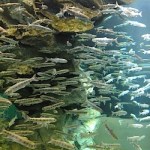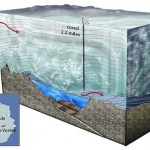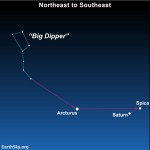lake
The cause of "angel wing", a deformity found in waterfowl such as ducks, geese and swans has been uncovered. Sadly, it is often caused by well-intended people feeding birds foods that are too high in proteins or carbohydrates (bread, crackers and popcorn anyone?). Not surprisingly, this condition mainly impacts birds that live in public areas. Because the deformed birds are unable to fly, thousands succumb every year to predators or inclement weather.
Conservationists suggest instead feeding the birds waterfowl feed, duck pellets, sliced seedless grapes, shredded swiss chard and romaine…
Image of Biwa salmon from the Lake Biwa Museum (http://www.lbm.go.jp/english/exhibits/aquarium.html)
It is not surprising that Biwa salmon (image above), a subspecies of Oncorhyncus masou, do not adapt to seawater very well after having been landlocked in Lake Biwa, Japan for the last 500,000 years or so. Researchers from Hokkaido University and Shiga Prefecture Fishery Experiment Station in Japan wanted to know what caused the salmon to lose their ability to thrive in salt water. In a new paper published in the American Journal of Physiology they compared the…
Could giant freshwater octopuses really be to blame for the many unexplained drownings in Oklahoma's lakes?
Lake Vostok (cross-section) prior to completion of drilling. Credit: National Science Foundation
Okay, this may not have anything to do with animal physiology...but then again maybe it does...
Russian scientists have just retrieved a core sample of frozen ice from the subsurface Lake Vostok in Antarctica that has been isolated from the outside world for at least 100,000 if not millions of years. The lake was protected by 4,000 meters of ice. The scientists drilled a hole that reached the surface of the lake and allowed the pressure from the lake to raise the water into the hole, where it…
"Everyone is a moon, and has a dark side which he never shows to anybody." -Mark Twain
Back before the telescope was invented, Saturn was known as the Old Man of the Skies. The slowest-moving of the naked-eye planets, it's the only one that would reliably be in nearly the same location, year after year. You can find it all summer, after sunset, by following the "arc" of the handle of the big dipper all the way until you run into the brightest northern-hemisphere star, Arcturus, and then speeding on to the very bright Spica. Saturn is right next door.
Image credit: EarthSky.org.
But…
Antarctica normally conjures images of white and blue, but the frozen continent can sometimes bear more unexpected colours. Take the Taylor Glacier - when geologist Griffith Taylor first explored it a century ago, he found a bizarre reddish stain that seemed to spill waterfall-like from the glacier's snout. The area became evocatively known as Blood Falls.
The source of the blood-red colour is an underground saltwater lake that was trapped by the encroaching glacier at least 1.5 million years ago. The temperature of the water is -5 Celsius, but it's so salty that it doesn't freeze. It'…
tags: nature, mountain, Image of the Day
I have been digging through my image archives in my gmail account and found some real treasures that my readers sent to me. Unfortunately, I overlooked quite a few images that were sent when I was in the hospital and had poor computer access. So let me fix this oversight during the next few weeks;
This looks like Mt. Rainier to me, but maybe one of you has a better idea of this mountain's identity (and also, what is the name of the lake in the forground?)
Orphaned image [larger view].


